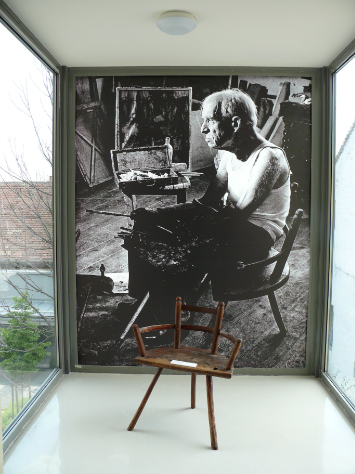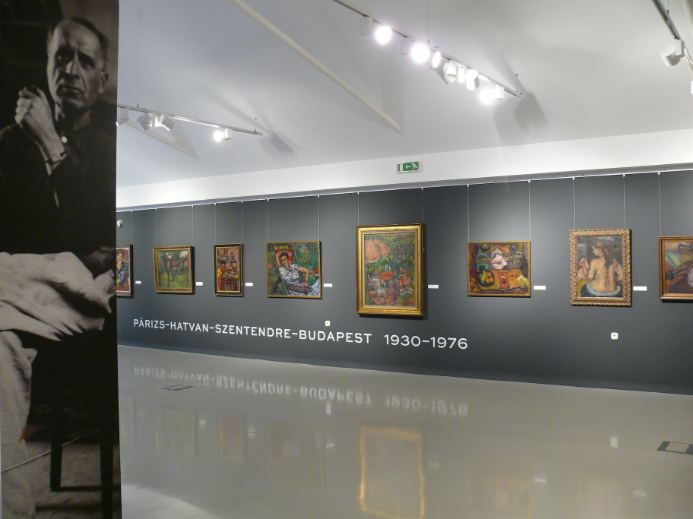The French Hungarian
CZÓBEL
Czóbel, a French Hungarian Painter is the title of the retrospective exhibition in the MűvészetMalom (ArtMill) in Szentendre, depicting the oeuvre of Czóbel’s 70 years as an artist.
| Szeredi Merse Pál |
2014-08-30 13:53 |
“Czóbel is a contemporary artist without unjustifiable sways which would risk the unity of nature and soul in his pictures. And his art – in a form which is instinctively linked to nature – retained the style creating strength of human and formal sovereignty, […] and this way he could remain modern and a true European even with his provincial and slack behaviour.” This is what Ernő Kállai said about Czóbel in 1925, and even knowing Czóbel’s oeuvre in the following 50 years, basically this opinion stands the test of time. Basically.

The difference between a retrospective view on the oeuvre and Kállai’s impressions, whose opinion was based on the first phase of Czóbel’s career, is constrained to one word: European. In 1925 Czóbel was a European painter. He was not Hungarian, not French and not even Dutch or German – although he could have been any of these. His most progressive and constructive critic could justifiably reproached him for being provincial and slack, but he could not question the essence of Czóbel’s work: being European.
However, in 2014, the retrospective exhibition does not bear the title: Czóbel, the European, but A Hungarian French, This title is justified by the fifty years of active work between Kállai’s book and Czóbel’s death. Defining him as a French Hungarian and not as a European or a French of Hungarian origin is one of the biggest challenges related to the painter. Being European or integrating into a different cultural context as an immigrant is always easier then becoming French and remaining Hungarian at the same time. However, Czóbel lived and worked this way and this is exactly what elevates him to the major figures of art history in Hungary.

Although Czóbel was a contemporary to the avant-garde and to its decline, he always remained an outsider, and perhaps this is what makes his oeuvre difficult to interpret. He could have been an impressionist in Nagybánya, but he chose Budapest. He could have been one of the fauves, but he painted pictures which were coarse (inculte) even for Louis Vauxcelles. In Hungary he could have been one the Nyolcak (The Eights – the most important avant-garde group in Hungary), but he never went to any of their exhibitions and sent a painting only to one. He could have been an expressionist too, one of Die Brücke, could have shared an atelier with Picasso, could have got involved in Cubism, and who knows how many other chances he had which could have changed his art entirely. Still, Czóbel was guarding „the style creating strength of human and formal sovereignty” which was although „a form instinctively linked to nature”, it was also unique and uninterrupted in his career.
 Despite this continuity, the exhibition space in Szentendre divides the Czóbel oeuvre into two sections, nevertheless following a chronological order. The two parts were curated by different people and their differing positions are clearly visible. Gergely Barki worked on the first section featuring Czóbel’s European period. He applied his unique approach of complementing. He does not accept if the artistic material is fragmented, but makes great efforts to complement the oeuvre with contemporary catalogues, critique or even with poor quality reproductions in order to fill the gaps and offer a comprehensive view of Czóbel. During the preparatory work, a lot of pictures were rediscovered and now they are there to refine the interpretation of the entire oeuvre from plein air in Nagybánya via the Academie Julian, the Salon d’Automne and the Salon des Independants to the periods in Amsterdam, Bergen, Würzburg, Berlin and finally in Paris.
Despite this continuity, the exhibition space in Szentendre divides the Czóbel oeuvre into two sections, nevertheless following a chronological order. The two parts were curated by different people and their differing positions are clearly visible. Gergely Barki worked on the first section featuring Czóbel’s European period. He applied his unique approach of complementing. He does not accept if the artistic material is fragmented, but makes great efforts to complement the oeuvre with contemporary catalogues, critique or even with poor quality reproductions in order to fill the gaps and offer a comprehensive view of Czóbel. During the preparatory work, a lot of pictures were rediscovered and now they are there to refine the interpretation of the entire oeuvre from plein air in Nagybánya via the Academie Julian, the Salon d’Automne and the Salon des Independants to the periods in Amsterdam, Bergen, Würzburg, Berlin and finally in Paris.
The second section of the exhibition – curated by Mimi Kratochwill, László Jurecskó and and Emőke Bodonyi – follows a longer but more balanced period of Czóbel’s life. In fact, from the 1930s, he is indeed the French Hungarian the exhibition title suggests: he resides at two places and it is hard two tell whether Szentendre or Paris is his second home. This is the Czóbel most people know, and these are the forms and colours so typical of him for half a century. His oeuvre was criticised by many, however, his unquestionably unique style made an impact in every possible context. Perhaps because of a certain homogeneity of his pictures in this period, the curators did not follow a strictly chronological order here, but instead, they chose to offer a rather topical grouping of the massive oeuvre.

Béla Czóbel’s art, even in its “lyrical brutality”, is complex and instructive, but its understanding is not easy. This unprecedentedly rich exhibition in Szentendre is now inviting everybody to take their chance.